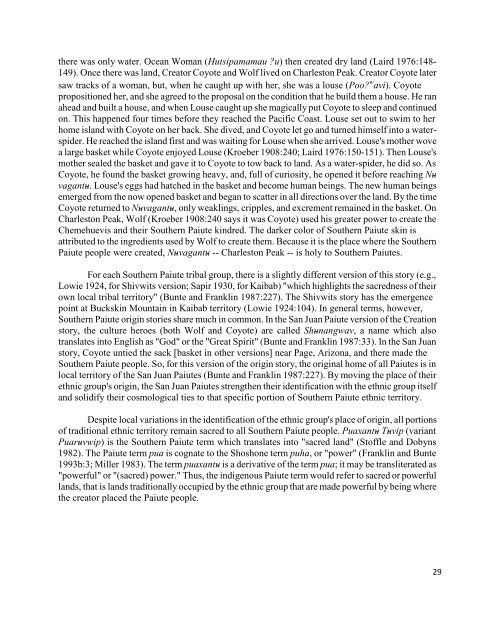Ethnographic Overview And Assessment: Zion National Park, Utah ...
Ethnographic Overview And Assessment: Zion National Park, Utah ...
Ethnographic Overview And Assessment: Zion National Park, Utah ...
You also want an ePaper? Increase the reach of your titles
YUMPU automatically turns print PDFs into web optimized ePapers that Google loves.
there was only water. Ocean Woman (Hutsipamamau ?u) then created dry land (Laird 1976:148-<br />
149). Once there was land, Creator Coyote and Wolf lived on Charleston Peak. Creator Coyote later<br />
saw tracks of a woman, but, when he caught up with her, she was a louse (Poo? w avi). Coyote<br />
propositioned her, and she agreed to the proposal on the condition that he build them a house. He ran<br />
ahead and built a house, and when Louse caught up she magically put Coyote to sleep and continued<br />
on. This happened four times before they reached the Pacific Coast. Louse set out to swim to her<br />
home island with Coyote on her back. She dived, and Coyote let go and turned himself into a waterspider.<br />
He reached the island first and was waiting for Louse when she arrived. Louse's mother wove<br />
a large basket while Coyote enjoyed Louse (Kroeber 1908:240; Laird 1976:150-151). Then Louse's<br />
mother sealed the basket and gave it to Coyote to tow back to land. As a water-spider, he did so. As<br />
Coyote, he found the basket growing heavy, and, full of curiosity, he opened it before reaching Nuvagantu-<br />
. Louse's eggs had hatched in the basket and become human beings. The new human beings<br />
emerged from the now opened basket and began to scatter in all directions over the land. By the time<br />
Coyote returned to Nu- vagantu- , only weaklings, cripples, and excrement remained in the basket. On<br />
Charleston Peak, Wolf (Kroeber 1908:240 says it was Coyote) used his greater power to create the<br />
Chemehuevis and their Southern Paiute kindred. The darker color of Southern Paiute skin is<br />
attributed to the ingredients used by Wolf to create them. Because it is the place where the Southern<br />
Paiute people were created, Nu- vagantu- -- Charleston Peak -- is holy to Southern Paiutes.<br />
For each Southern Paiute tribal group, there is a slightly different version of this story (e.g.,<br />
Lowie 1924, for Shivwits version; Sapir 1930, for Kaibab) "which highlights the sacredness of their<br />
own local tribal territory" (Bunte and Franklin 1987:227). The Shivwits story has the emergence<br />
point at Buckskin Mountain in Kaibab territory (Lowie 1924:104). In general terms, however,<br />
Southern Paiute origin stories share much in common. In the San Juan Paiute version of the Creation<br />
story, the culture heroes (both Wolf and Coyote) are called Shu- nangwav, a name which also<br />
translates into English as "God" or the "Great Spirit" (Bunte and Franklin 1987:33). In the San Juan<br />
story, Coyote untied the sack [basket in other versions] near Page, Arizona, and there made the<br />
Southern Paiute people. So, for this version of the origin story, the original home of all Paiutes is in<br />
local territory of the San Juan Paiutes (Bunte and Franklin 1987:227). By moving the place of their<br />
ethnic group's origin, the San Juan Paiutes strengthen their identification with the ethnic group itself<br />
and solidify their cosmological ties to that specific portion of Southern Paiute ethnic territory.<br />
Despite local variations in the identification of the ethnic group's place of origin, all portions<br />
of traditional ethnic territory remain sacred to all Southern Paiute people. Puaxantu- Tu- vip (variant<br />
Puaru- vwip) is the Southern Paiute term which translates into "sacred land" (Stoffle and Dobyns<br />
1982). The Paiute term pua is cognate to the Shoshone term puha, or "power" (Franklin and Bunte<br />
1993b:3; Miller 1983). The term puaxantu- is a derivative of the term pua; it may be transliterated as<br />
"powerful" or "(sacred) power." Thus, the indigenous Paiute term would refer to sacred or powerful<br />
lands, that is lands traditionally occupied by the ethnic group that are made powerful by being where<br />
the creator placed the Paiute people.<br />
29

















